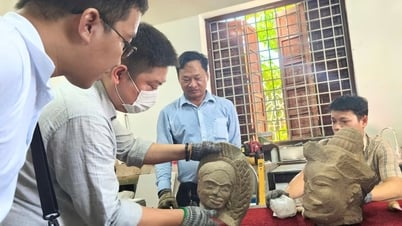Attending the conference were Minister of Education and Training Nguyen Kim Son; Minister, Chairman of the Ethnic Minorities Committee Hau A Lenh; Secretary of Dak Lak Provincial Party Committee Nguyen Dinh Trung; Vice Chairman of the National Assembly's Committee for Culture and Education Nguyen Thi Mai Hoa; Standing member of the National Assembly's Ethnic Minorities Council Leo Thi Lich.
Also attending were representatives of the Ministry of Finance, the Ethnic Committee, the Government Office ; leaders of the People's Committees and Departments of Education and Training of 5 provinces in the Central Highlands: Dak Lak, Gia Lai, Kon Tum, Dak Nong, Lam Dong; leaders of functional Departments and Bureaus of the Ministry of Education and Training; representatives of leaders of educational and training institutions in the region.

Conference Overview
Reporting on the current stateof education and training in the Central Highlands region in the period of 2011-2022, Deputy Minister of Education and Training Nguyen Van Phuc said: Over the past 10 years, the school network system has been consolidated and widely developed, meeting the diverse learning needs of the people. Basically, there are no more communes without preschool education, every village has a preschool class. All communes have primary schools. Most communes have junior high schools, and all districts have high schools. Many localities have built inter-commune junior high schools and high schools. Currently, the whole region has 3,984 preschool, general and continuing education facilities.
Notably, the rate of mobilizing 5-year-old preschool children to attend school in the Central Highlands reached 99.6% - higher than the national average and ranked 3rd nationwide. 100% of 5-year-old children in preschools attend 2 sessions/day - higher than the national average and higher than both the Southeast and Mekong Delta regions.
The rate of students attending school at the right age at all three levels has increased in recent years, equivalent to the national average and other regions. In the 2020-2021 school year, 5/5 provinces in the Central Highlands maintained and met the standards for universal primary education. The rate of primary education institutions organizing 2 sessions/day reached 94.1%; The rate of secondary education institutions organizing 2 sessions/day reached 84%, nearly double that of 10 years ago.
The whole region has 59 ethnic boarding schools and 68 semi-boarding schools. Of these, 49/59 ethnic boarding schools (accounting for 83.05%) are recognized as meeting national standards. The quality of education at ethnic boarding and semi-boarding schools has improved over each school year.
Although the average income per capita ranks 5th out of 6 regions in the country, only higher than the Northern Midlands and Mountains. However, the Central Highlands is one of the regions with the highest growth rate of non-public education in the country. In the 2020-2021 school year, the whole region has 261 non-public preschool and general education institutions, an increase of 150 educational institutions compared to 10 years ago.

Minister of Education and Training Nguyen Kim Son speaks at the Conference
The Central Highlands region currently has 9 universities and university branches, 4 teacher training colleges and 107 vocational training institutions. The region has 30,221 university students, of which 13.3% are ethnic minority students. The proportion of trained workers is 50.2%.
Despite many efforts, with difficult socio-economic conditions, the quality of education in the Central Highlands is still lower than the national average. Most of the region's education quality indicators are lower than the national average and those of other regions. The quality of human resources, especially ethnic minority human resources, has not met the requirements. The proportion of the population aged 15 and over with intermediate, college and university degrees has increased but is still low compared to the national average. This is a barrier to the socio-economic development of localities in the region.
The Central Highlands Education Department aims to have the Central Highlands' education and training quality indicators approaching the national average by 2030. By 2045, the development of preschool education, general education, and continuing education will approach that of other regions across the country and gradually approach the education system in the region.
The conference recorded the opinions of the leaders of 5 provinces in the Central Highlands and representatives of some universities in the region. The opinions of the localities focused on sharing the efforts and achievements in the field of education and training in recent times. Although there are still many difficulties due to economic life and the large number of ethnic minorities, each locality, with appropriate policies and practices, has created changes in education and training, contributing to the overall development of the locality.
One of the difficulties discussed by all five provinces is that the natural and mechanical population growth rates due to spontaneous migration in the provinces are very high. Vice Chairwoman of Dak Nong Province Ton Thi Ngoc Hanh said that each year Dak Nong Province increases by 35,000 students due to spontaneous migration, so the shortage of teachers becomes even more acute.
The recommendations sent by localities to the National Assembly, the Government, the Ministry of Education and Training and other ministries and branches focus on development policies, improving the quality of teachers; increasing investment sources for ethnic minority areas and difficult border areas - according to some localities, there are currently many national target programs for ethnic minority areas, but the integration into education is still limited and difficult to implement.
The 10% staff reduction in localities, including the education sector, is causing difficulties for localities that are already short of teachers at all levels. Therefore, localities have requested the Ministry of Home Affairs to consider the retirement age of preschool teachers to ensure the difficult nature of the profession and to train teachers of ethnic minority languages to create a source of recruitment, which are also the contents proposed by the provinces in the Central Highlands.
Sharing the difficulties of education in the Central Highlands, Minister and Chairman of the Ethnic Committee Hau A Lenh also highly appreciated the efforts of Party committees and authorities at all levels, the efforts of teachers and each family in taking care of the development of education and training.
Discussing specifically some issues that ethnic minority education needs to pay attention to and solve in the current period, Minister and Chairman of the Ethnic Committee Hau A Lenh said: Those are policies for students in priority areas; teaching literacy to ethnic minority students; developing local teachers who are ethnic minorities; preserving and teaching ethnic cultural identity...
Wishing that the Central Highlands would have more universities and university branches to train and improve the quality of local human resources, Minister and Chairman of the Ethnic Committee Hau A Lenh also said that he would accept recommendations from localities and coordinate with the Ministry of Education and Training to consider adjusting and advising on appropriate policy adjustments, creating conditions for education in the Central Highlands to develop.
Concluding the Conference, Minister Nguyen Kim Son emphasized: Developing education nationwide has common policies and common issues, but each region has its own characteristics and peculiarities, and seeing the peculiarities of each region will be very important in designing and implementing policies.
Referring to the advantages and difficulties of the Central Highlands, Minister Nguyen Kim Son commented: The Central Highlands education sector is facing a heavier task than other regions. It must not only solve the difficult requirements of keeping up with other regions but also carry out innovation like all regions, along with fulfilling its duties to ethnic minorities. “Adding together, if other regions try 1, we try 2-3. This is a characteristic of the Central Highlands education sector and a heavy challenge,” said the Minister.

Minister, Chairman of the Ethnic Committee Hau A Lenh speaks at the Conference
With the characteristics of a region with diverse ethnicities, cultures, religions, and beliefs, it is necessary to preserve those cultural values; the characteristics of a region with agricultural production as the main production requiring the urgent need to improve people's knowledge; and the characteristics of a region with the lowest rate of university students in the country, it is urgent to increase the rate of university students to have high-quality human resources... are the next 3 issues mentioned by the Minister in the group of characteristics and features of education and training in the Central Highlands region.
Discussing some major tasks ahead, Minister Nguyen Kim Son emphasized the activities of summarizing 10 years of implementing Resolution 29 on fundamental and comprehensive innovation of education and training and the supervision activities of the National Assembly Standing Committee on innovation of general education programs and textbooks, with the request that localities will have complete and objective summaries and assessments of what has been done and what has not been done and make maximum recommendations on outstanding issues and wishes.
With the 2018 General Education Program being implemented nationwide, the Minister noted the process of implementation so as not to be rigid or hasty in evaluation as well as to have a roadmap for implementation. The Minister also noted the initiative in implementing the new program of each locality, school, and teacher. The Minister hopes that localities will give high priority to investing in facilities, teachers, and human resources for the two years 2023-2024 so that "the investment rhythm falls at the most important implementation time".
In addition, the Central Highlands provinces also need to pay attention to a number of other issues such as properly implementing 20% of the budget expenditure for education; focusing on consolidating schools; carefully and reasonably arranging regulations; further promoting the socialization of education, in which both paying attention to and creating conditions and fully implementing state management of socialization work...
Minister of Education and Training Nguyen Kim Son expressed his hope that, through this Conference, the localities that have paid attention will continue to pay attention and pay attention in a more appropriate and proper way to develop education and training, thereby developing the socio-economy of the region.
HOANG HUONG
Source
































































































Comment (0)